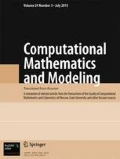We investigate a controlled version of the well-known business cycle model proposed by Nicholas Kaldor. The control is introduced by a parameter that characterizes demand stimulation by the state. The cost of the stimulating policy is a quadratic function; the instantaneous utility function is defined as the national income less demand-stimulation costs. We show that with nearly-maximal demand, an asymptotically stable stationary state always exists in the model. Under fairly general assumptions, we prove existence and uniqueness of the optimal stationary state. The problem of the shortest-time transition of the system to a given stationary state is considered. Numerical simulation results are reported. Keywords: dynamic models in economics, Kaldor business-cycle model, stability, optimality, stationary state, minimum-time problem.
Similar content being viewed by others
References
Yu. N. Kiselev, S. N. Avvakumov, and M. V. Orlov, Optimal Control. Linear Theory and Applications [in Russian], MAKS Press, Moscow (2007).
L. S. Pontryagin, V. G. Boltyanskii, R. V. Gamkrelidze, and E. F. Mishchenko, Mathematical Theory of Optimal Processes [in Russian], Fizmatgiz, Moscow (1961).
T. V. Ryazanova, Stochastic Attractors and Noise-Induced Events in Dynamic Economic Models [in Russian], Research report, Ural Federal University, Ekaterinburg (2013).
L. A. Tarasevich, V. M. Gal’perin, P. I. Grebnikov, and A. I. Leusskii, Macroeconomics [in Russian], Izd. SPbGUEF, St. Peterburg (1999).
A. F. Filippov, “On some issues in optimal control theory,” Vestnik MGU, No. 2, 25–32 (1959).
Ph. Hartmann, Ordinary Differential Equations [Russian translation], Mir, Moscow (1970).
D. Acemoglu, Introduction to Modern Economic Growth, Princeton Univ. Press, Princeton, NJ (2008).
W. W. Chang and D. J. Smyth, “The existence and persistence of cycles in a nonlinear model: Kaldor’s 1940 model re-examined,” The Review of Economic Studies, 38, No. 1, 37–44 (1971).
N. Kaldor, “A model of trade cycle,” The Economic Journal, 50, No. 197, 78–92 (1940).
A. Krawiec and M. Szydalowski, “On nonlinear mechanics of business cycle model,” Regular and Chaotic Dynamics, 6, No. 1, 101–118 (2001).
H.-W. Lorenz, Nonlinear Dynamical Economics and Chaotic Motion, Springer, Berlin (1993).
A. W. Phillips, “Stabilisation policy in a closed economy,” Economic Journal, 64, No. 254, 290–323 (1954).
M. J. Weitzman, Income, Wealth, and the Maximum Principle, Harvard University Press, Cambridge, MA (2003).
Author information
Authors and Affiliations
Corresponding author
Additional information
Translated from Problemy Dinamicheskogo Upravleniya, No. 8, 2017, pp. 5–17.
Rights and permissions
About this article
Cite this article
Aseev, A.S. Dynamic Optimization of the Controlled Model of the Kaldor Business Cycle. Comput Math Model 31, 158–168 (2020). https://doi.org/10.1007/s10598-020-09485-9
Published:
Issue Date:
DOI: https://doi.org/10.1007/s10598-020-09485-9




